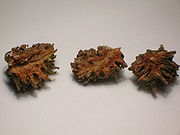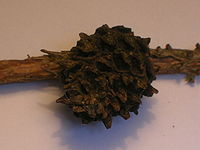
Pineapple gall adelgid
Encyclopedia

Norway Spruce
Norway Spruce is a species of spruce native to Europe. It is also commonly referred to as the European Spruce.- Description :...
and Sitka Spruce
Sitka Spruce
Picea sitchensis, the Sitka Spruce, is a large coniferous evergreen tree growing to 50–70 m tall, exceptionally to 95 m tall, and with a trunk diameter of up to 5 m, exceptionally to 6–7 m diameter...
.
The aphid
Aphid
Aphids, also known as plant lice and in Britain and the Commonwealth as greenflies, blackflies or whiteflies, are small sap sucking insects, and members of the superfamily Aphidoidea. Aphids are among the most destructive insect pests on cultivated plants in temperate regions...
-like insect Adelges lays up to one hundred eggs, one on each needle. Adelges abietis (Linnaeus, 1758) is one of the most common species, synonyms are A. gallarum-abietis, Chermes abietis and Sacciphantes abietis.
Terminology and distribution
Prominent in appearance, the pineapple or pseudocone gall is often confused with the actual cone of the tree, despite its small size, position and the habit of the branch growing on past the gall. Spruce gall aphid, eastern spruce pineapple gall adelges and eastern spruce gall aphid are alternative names. This insect belongs to the superfamily Aphidoidea, and family Adelgidae.The pineapple gall adelgid, is a native of Europe, belonging to the 'Woolly Aphid' group; it is also widely distributed in the north-eastern United States. It is the primary pest of Norway spruce. Another species, the Cooley spruce gall adelgid is indigenous to North America. This adelgid usually affects Colorado blue, Sitka, Englemann, and Oriental spruces.
The physical appearance of the pineapple gall


As stated, Sitka and Norway spruce are the main hosts, but A. abietis galls can be found on Colorado blue, white, and red spruces.
The yellowish green galls pass through pink and then reddish brown colour phases. They measure 1.5 to 3.0 cm in length.
Similar galls are produced by other aphids: on Sitka Spruce by the Cooley spruce gall adelgid, Gilletteela cooleyi, some generations of which migrate to Douglas fir (Pseudotsuga taxifolia); and on spruce by Cnaphalodes sp., which is heteroecious with larch. The Cooley spruce gall adelgids form a larger gall, 1 to 3 in (25.4 to 76.2 mm) long, which usually covers the entire tip of infested new growth.
Life-cycle

In June to July the hatched adelgids mature and crawl out onto the needles, where they moult and develop wings. These aphids may fly to other conifers, such as Larch (Larix), Pine (Pinus) and Silver Fir
Silver Fir
Abies alba, commonly known as the European silver fir, is a fir native to the mountains of Europe, from the Pyrenees north to Normandy, east to the Alps and the Carpathians, and south to southern Italy and northern Serbia.-Description:...
(Abies alba) or may continue the cycle on the same tree as they are poor flyers. Several generations are raised on these secondary hosts, however no galls are formed. In July of the following year winged aphids appear and fly to the spruces to breed there again, completing the life-cycle.
The Adelgid are pear-shaped, soft-bodied green insects with long antennae and are not typical aphids.
Gall forming insects
Some herbivorousHerbivore
Herbivores are organisms that are anatomically and physiologically adapted to eat plant-based foods. Herbivory is a form of consumption in which an organism principally eats autotrophs such as plants, algae and photosynthesizing bacteria. More generally, organisms that feed on autotrophs in...
insects therefore create their own microhabitats by forming, in this case, a highly distinctive plant structure called a gall
Gall
Galls or cecidia are outgrowths on the surface of lifeforms caused by invasion by other lifeforms, such as parasites or bacterial infection. Plant galls are abnormal outgrowths of plant tissues and can be caused by various parasites, from fungi and bacteria, to insects and mites...
, made up of plant tissue, but controlled by the insect. Galls act as both the habitat, and food sources for the maker of the gall. The interior of a bedeguar gall is formed from the bud, and is composed of edible nutritious and structural tissues. Some galls act as "physiologic sinks", concentrating resources in the gall from the surrounding plant parts. Galls may also provide the insect with some physical protection from predators.
Infestations of pineapple galls
Galls interfere with the natural formation of twigs and cause curling, stunting and the eventual death of new growth. Heavy infestations give the trees a ragged appearance and destroy their beauty. Thus galls prevent twig growth and, if they are abundant, may affect entire trees. Individual trees vary in susceptibility to attack; some appear immune, others suffer growth reduction, and some are eventually killed. Trees growing on good sites are generally less susceptible to attack than those on poor sites.Control
Although the old galls can be unsightly this pest has little lasting impact. On small trees galled shoot tips can be cut off but generally this is a pest that can be tolerated.Biological control
There are no known effective parasites or predators of Adelges abietis. Specimen trees in gardens may be afforded a degree of protection by hanging up fat balls to encourage tits which will also feed on the adelgid gall formers.Pesticides
If control measures are required, spray with bifenthrin on a dry, mild day in late February to control the overwintering generation.See also
- Knopper gallKnopper gallAndricus quercuscalicis is a gall wasp species inducing Knopper galls.Knopper galls develop as a chemically induced distortion of growing acorns on Pedunculate Oak trees, caused by gall wasps, which lay eggs in buds with their ovipositor...
- Oak marble gallOak marble gallOak marble galls develop as a chemically induced distortion of leaf buds on pedunculate oak , or sessile oak trees, caused by the parthenogenetic gall wasp which lays eggs within leaf buds using their ovipositor...
- Oak appleOak appleOak apple is the common name for a large, round, vaguely apple-like gall commonly found on many species of oak. Oak apples range in size from 2-5cm. Oak apples are caused by chemicals injected by the larva of certain kinds of gall wasp in the family Cynipidae. The adult female wasp lays single...
- GallGallGalls or cecidia are outgrowths on the surface of lifeforms caused by invasion by other lifeforms, such as parasites or bacterial infection. Plant galls are abnormal outgrowths of plant tissues and can be caused by various parasites, from fungi and bacteria, to insects and mites...
- Oak artichoke gallOak artichoke gallOak artichoke galls, oak hop galls, larch-cone galls or hop strobiledevelop as a chemically induced distortion of leaf axillary or terminal buds on Pedunculate Oak or Sessile Oak trees, caused by the parthenogenetic gall wasp Andricus fecundator, which lays single eggs within leaf buds using...
- Alder tongue gallAlder tongue gallTaphrina alni is a fungal plant pathogen that causes Alder tongue gall, a chemically induced distortion of female alder catkins ....

